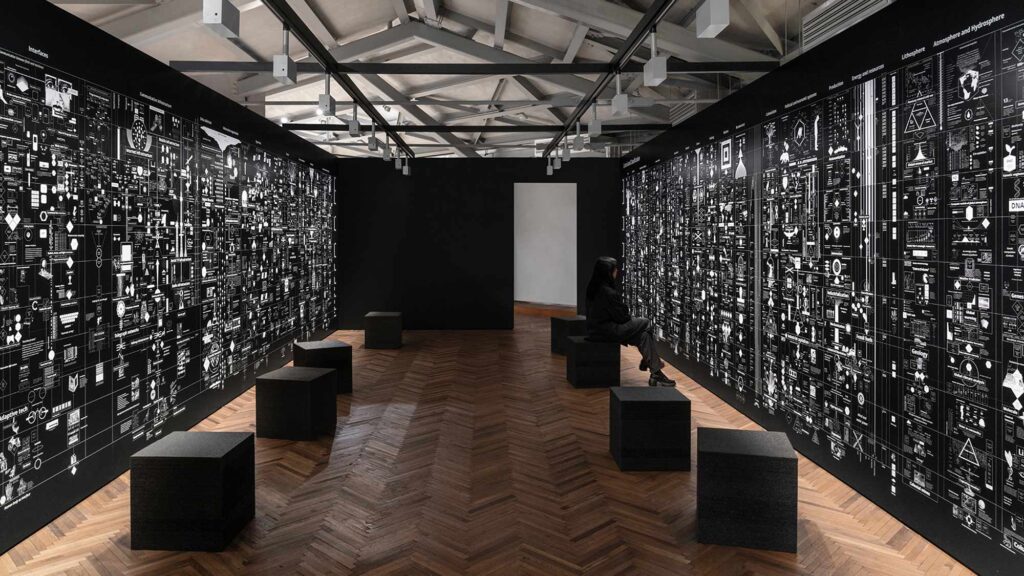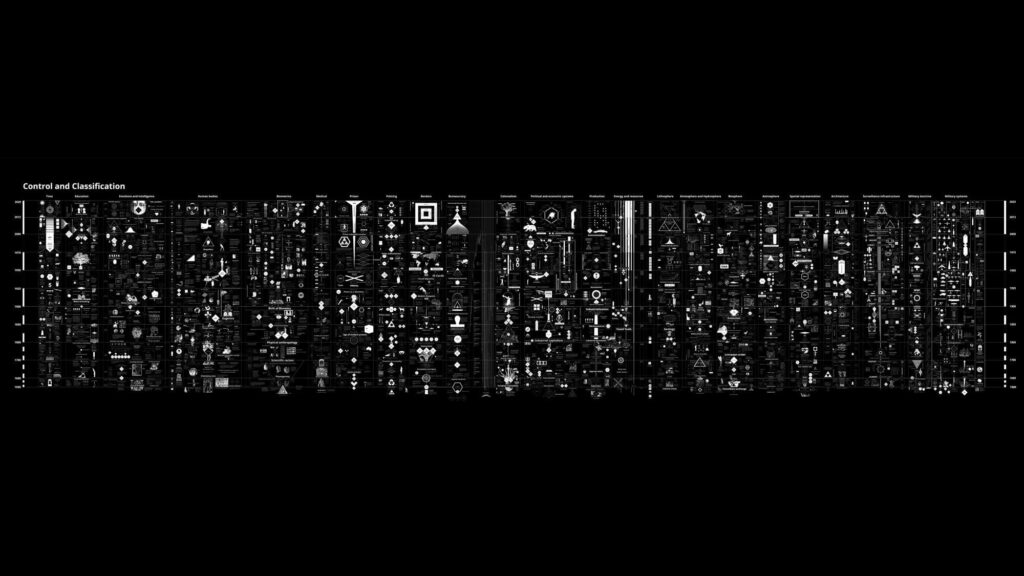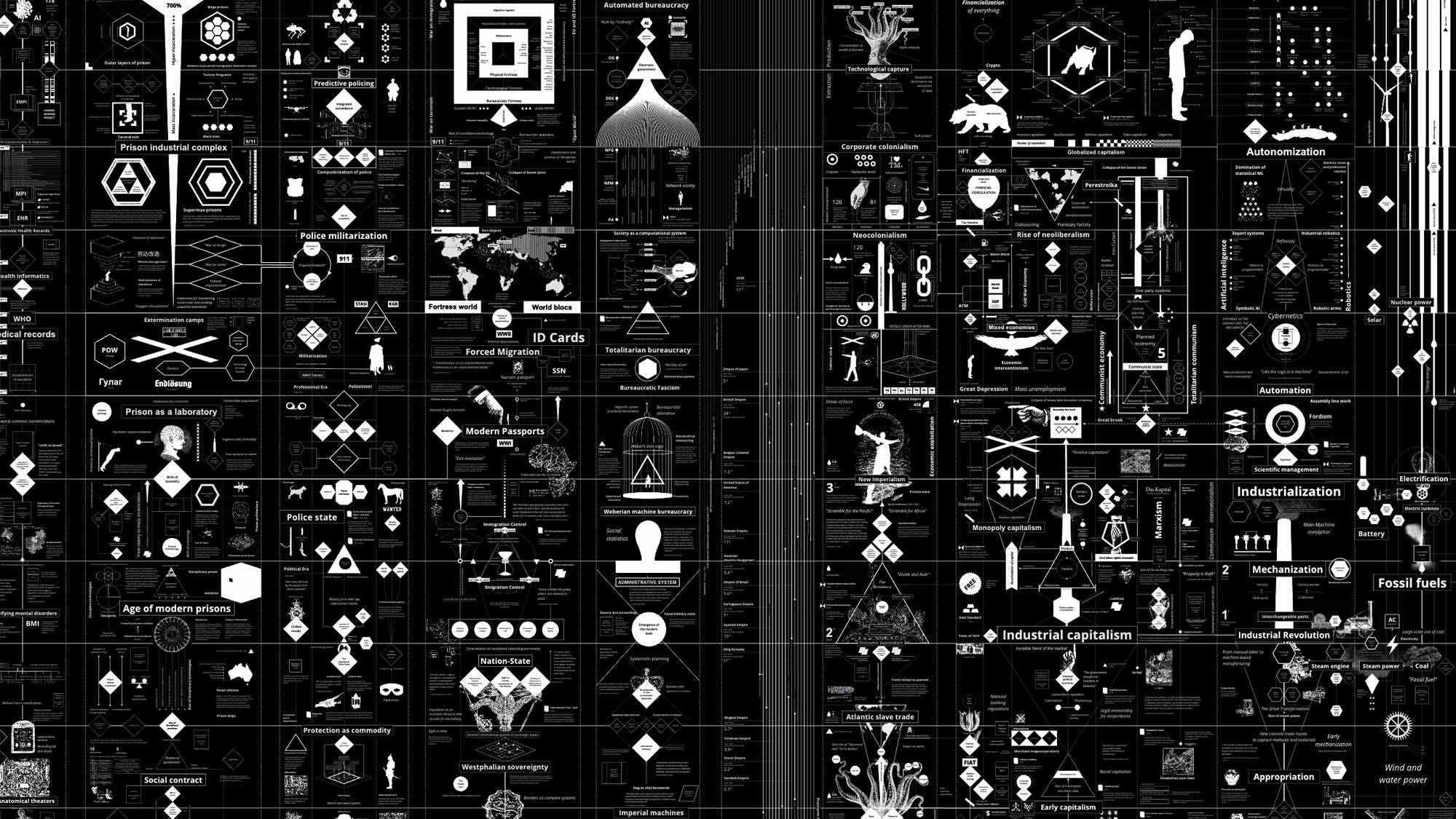Grand Prize – Artistic Exploration
Awarded for artistic exploration and art works where appropriation by the arts has a strong potential to influence or alter the use, deployment, or perception of technology.
Calculating Empires is a large-scale visual manifesto by Kate Crawford and Vladan Joler that critically engages with the relationship between technology and power over five centuries. By merging research and design, science and art, Joler and Crawford go beyond the current spectacles of artificial intelligence to ask how we got here—and consider where we might be going. This vast diagram follows the imperial pathways of power since 1500 across many systems—colonialism, militarization, and automation—to show how they still subjugate and how they might be unwound. By illustrating this history, Calculating Empires charts a new way of seeing our technological present by immersing us in the past, from the birth of European empires to the technology companies of today.

Spanning more than twenty-four meters in length and three meters in height, Calculating Empires is designed as a diptych. One half focuses on the changing spectrum of communication devices, infrastructures, and computational architectures of algorithms and hardware. The other half tells the story of control and classification across dozens of domains: from time to education, bodies to biometrics, policing to prisons, the biosphere to the astrosphere, and a multitude of military systems. Read together, these maps visualize how technical and social structures co-evolved over centuries, with hundreds of handcrafted illustrations and texts that draw relationships between devices, ideas, and infrastructures.
Calculating Empires premiered at an exhibition of Crawford and Joler’s work at Fondazione Prada in Milan in November 2023, and then moved to Berlin as part of a group show called Poetics of Encryption at the KW Institute for Contemporary Art. Like their previous work, Anatomy of an AI System, Calculating Empires is a research-driven detailed visual narrative about the relationship between humans, ecologies, and technologies. But where Anatomy was mapping out space, Calculating Empires is about time. It offers an alternative perspective to the current short-termism in technology criticism and art, which is frequently focused on the most recent spectacles and devices at the expense of deeper historical and political shifts.

Calculating Empires begins in 1500, when global networks—both cultural and mercantile—began to take shape. New trade routes meant the expansion of European empire. Advances in shipping and navigational instruments enabled rapid annexation of lands and annihilation of Indigenous populations via new viruses, drugs, and weapons. The Gutenberg Press reorganized information power and laid the groundwork for a political and cultural transformation. New scientific instruments and calculation systems were developed. The meticulous cataloguing and privatization of land, animals, plants, and space commenced a layered agenda of colonization that expanded over hundreds of years. These practices of past empires are now echoed in the highly concentrated technology and military industries of the 21st century.

In a time of widespread automated image generation and text production, their methods were painstakingly manual. Over the four years of making this map together, and creating thousands of short texts and illustrations, they slowly expanded, unlearned, revised, and reconsidered the traditional account of technological history. They returned to the painful stories of upheavals and removals, massacres and enclosures that are the recurring stories of calculation and empire. The work resists telling a totalizing history, but instead offers a visual genealogy: how to calculate the technological present through the lens of the past.

The large-scale diagrams are accompanied by two handmade volumes. Visitors are invited to read, revise, and annotate them with their own accounts of history. At each location where this work will be shown, the books will be different: reflecting the comments, stories, and experiences of the place it was installed.
Credits
Calculating Empires: A Genealogy of Technology and Power, 1500–2025
Artists: Kate Crawford and Vladan Joler (2023)Research and design associate: Sarah Ciston
Research assistants: Francis Corry, Edward Kang, Will Orr, and Hamsini Sridharan
Project management: Hannah Franklin and Michael Weinberg
Website production: Olivia Solis Villaverde and Milutin Marinovic
With thanks to Prof. Dubravko Culibrk, Prof. Bernard Geoghegan, Dr. Sasha Luccioni, Prof. Xiaochang Li, Dr. Ida Momennejad, Prof. John Modern, Trevor Paglen, Prof. Justin E. H. Smith, and Prof. Fred Turner
With support from: The Sloan Foundation, as part of the Knowing Machines project (https://knowingmachines.org);
The Robert Bosch Academy (https://www.robertboschacademy.de/);
Fondazione Prada (https://www.fondazioneprada.org/project/calculating-empires/)
Biographies
Prof. Kate Crawford (US) is a leading scholar of the impacts of artificial intelligence. She is a professor at USC in Los Angeles, a senior principal researcher at MSR New York, and the inaugural chair of AI and Justice at the École Normale Supérieure. Her book Atlas of AI won multiple awards, was named a book of the year by Science and the Financial Times, and is translated into 12 languages. She leads the Knowing Machines project, an international research collaboration on the foundations of AI. Her artworks have been acquired by museums such as MoMA and the V&A, and received the Aryton Prize. Kate was named by TIME magazine’s TIME100 as one of the most influential people in AI.
Prof. Dr. Vladan Joler (RS) is an academic, researcher, and artist whose work blends data investigations, critical cartography, investigative journalism, and data visualization. He is SHARE Foundation co-founder and professor at the New Media Department of the University of Novi Sad. Vladan Joler’s work is in the permanent collections of the Museum of Modern Art (MoMA), the V&A Museum, and the Design Museum in London, and also in the permanent exhibition of the Ars Electronica Center. His work has been exhibited in more than a hundred international exhibitions worldwide.
Jury Statement
How can we understand the entanglement between technology and power today? The technological systems, from AI chatbots to international border controls, are increasingly automated and opaque. If the world is to address the current challenges of the climate crisis, hallucinating AI systems, and war, we need to understand how these processes are interwoven.
Calculating Empires charts the technological present by depicting how power and technology have been intertwined since 1500. It is a codex of technology and power that shows how echoes of empires past resonate in today’s technology companies. With thousands of individual drawings and texts, Kate Crawford and Vladan Joler visualize these major shifts in an intricate visual manifesto about the way empires have used technology to centralize and consolidate their power. The vast diagrammatic diptych draws audiences into a dark passage to study on one wall the histories of communication and computation, while the opposite wall addresses systems of classification and control. Read together, these maps illuminate technical and social structures that co-evolved over centuries. By seeing how past powers have calculated, we can begin to calculate the costs of contemporary empires. Calculating Empires thus gives audiences a detailed visual narrative about the relationship between humans, ecologies, and technologies. It traces the ways that technology and power have been entwined over five centuries, through industrialization, imperialism, and automation. It shows how practices of colonialism, militarization, and enclosure operate today and how they might be unwound. It establishes itself as a necessary corrective to the current short-termism in technology criticism and art, which is frequently focused on the most recent spectacles and devices, at the expense of deeper historical and political shifts. Calculating Empires challenges us to redefine our relationship with current socio-technical structures. By asking how we got where we are today, we can (re-)consider where we might be going



